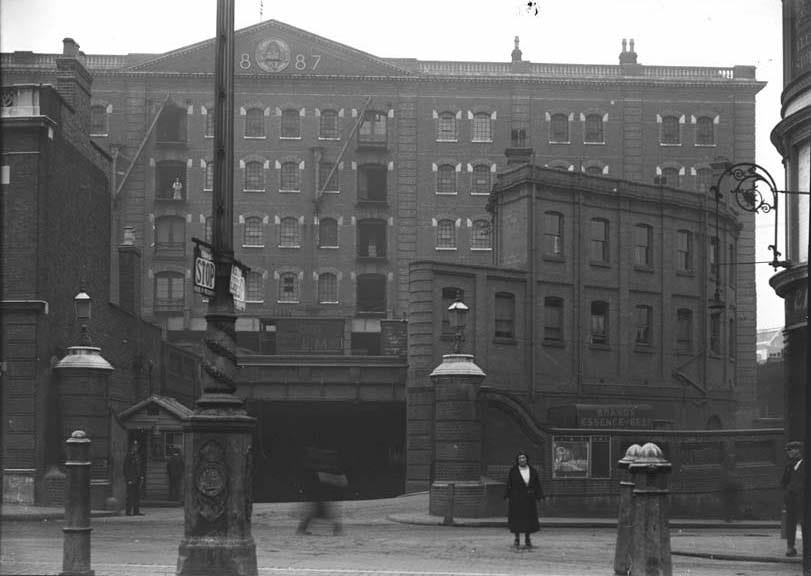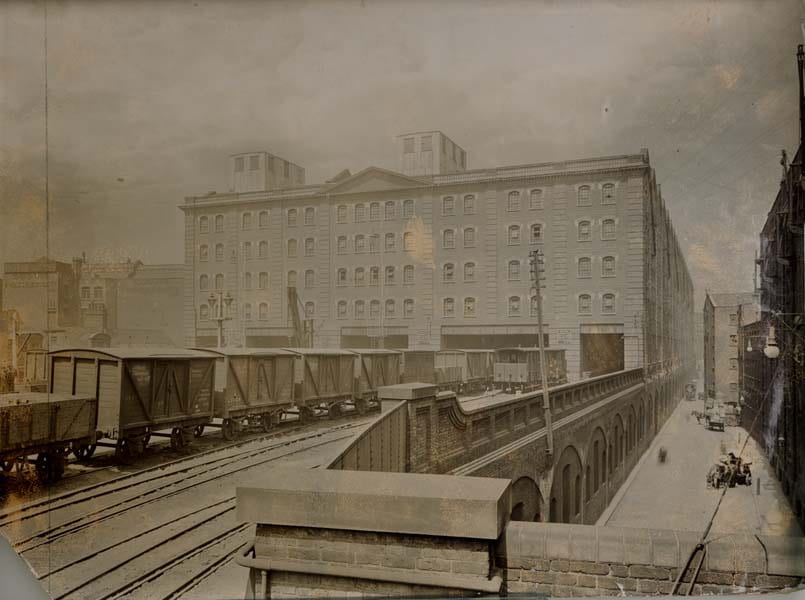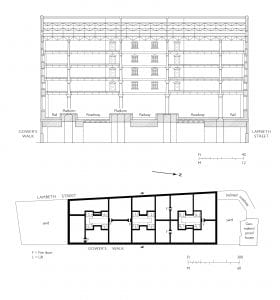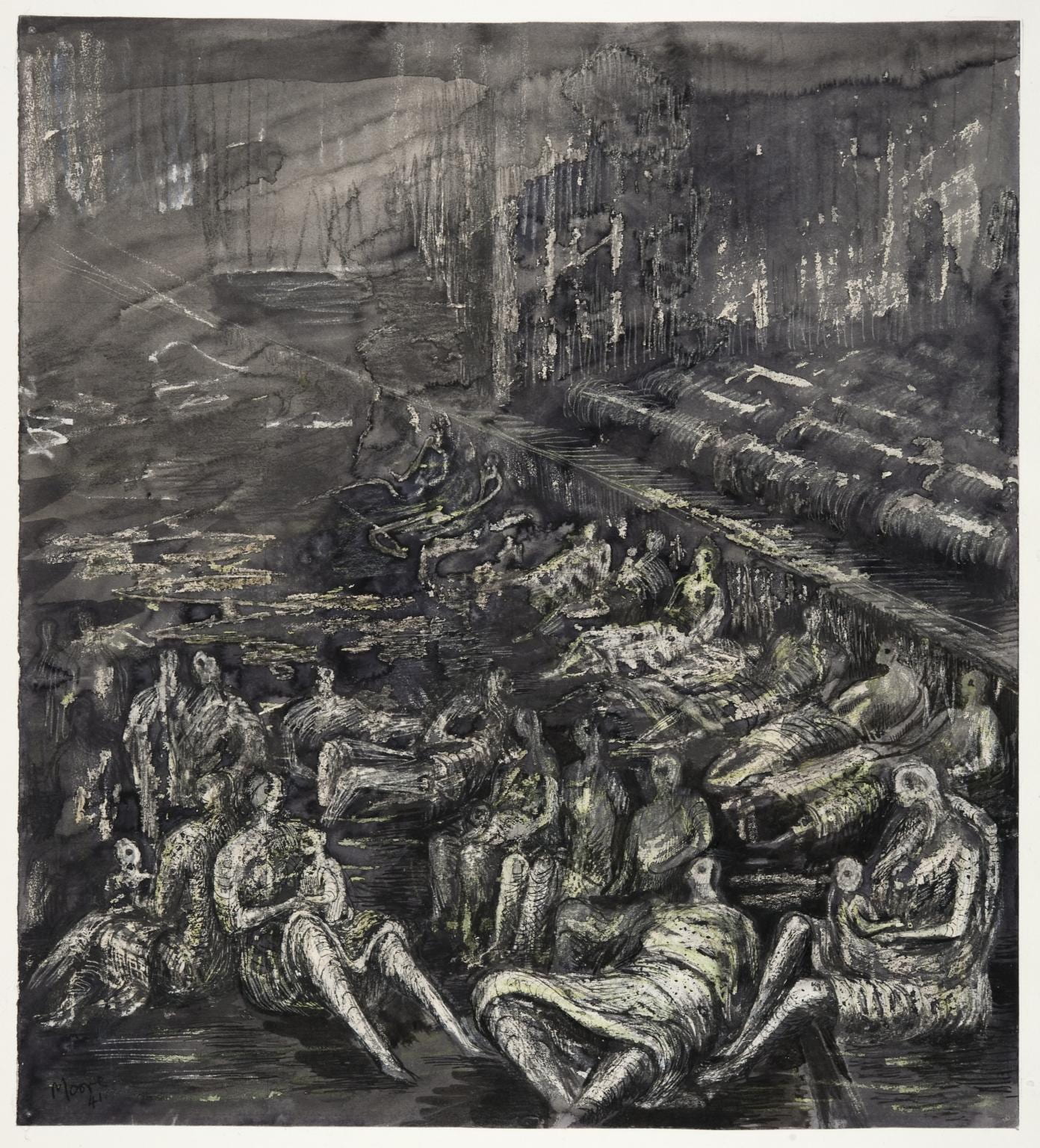The Tilbury Shelter
By the Survey of London, on 17 April 2020
During the Blitz in 1940–1 a Whitechapel building, the Commercial Road Goods Depot, housed the East End’s single biggest bomb shelter. The history of what was known as the Tilbury Shelter seems timely, if only as a reminder of how different that crisis was from the one we are presently living through. What follows is based on research and text prepared for the Survey of London by Rebecca Preston. We would like also to acknowledge help from Robert Thorne, Tim Smith and Peter Kay.

Commercial Road Goods Depot from the north, c.1905 (© Museum of London/PLA Collection)

Commercial Road Goods Depot from the south, c.1905 (© Museum of London/PLA Collection)
The Commercial Road Goods Depot was a behemoth of a building that extended from the Commercial Road near its west end as far south as the viaduct of the London and Blackwall Railway, beside Cable Street. It was built in 1884–7 by the London, Tilbury and Southend Railway Company as a receiving and forwarding depot for merchandise dealt with at the East and West India Dock Company’s Tilbury Docks, which opened in 1886. The premises comprised ground-level vaults with viaduct-level sidings, a shunting yard and a branch line, and a goods station below the colossal warehouse. It was all demolished in 1975.

Commercial Road Goods Depot, plans at street-level (left) and upper rail-level (right) (drawn by Helen Jones for the Survey of London based on drawings by Tim Smith)
The London, Tilbury and Southend became part of the London, Midland and Scottish Railway Company (LMS) in 1923 as part of the ‘grouping’ or reorganisation imposed on private railway companies following the experience of government-run railways during the First World War. The lower levels of the Commercial Road goods depot served as general stores. The warehouse above was bonded and used by the Port of London Authority (PLA), the public trust that succeeded London’s private dock companies in 1909, as vast tea stores containing 78,000 chests.

Bulking tea for the PLA in the Commercial Road warehouse (from William Ukers, All About Tea, 1935)
In April 1940 the LMS agreed to the use of the Commercial Road Goods Depot as an air-raid shelter, provided Stepney Borough Council scheduled sufficient wardens to work under the company’s police, and that notices prohibiting smoking were put up in English and Yiddish. Initially the plan, probably a temporary measure, was to create two adjoining shelters, one for LMS personnel and a second ‘PLA Shelter’, above, for 1,400 members of the public. There were fears that ‘people caught in the streets would rush for this shelter as they did during the last war’.1 In preparation, the PLA’s engineers, Rendel, Palmer & Tritton, oversaw the bricking up of lower windows. However, when Stepney Council proposed using both the PLA and LMS sections as an official public air-raid shelter, the lower LMS section was refused approval by the Ministry of Home Security because it would involve ‘dangerously large concentrations of people in one shelter and because the Railway Company insisted that the roadway through the LMS sections be kept open for traffic’.2

Commercial Road Goods Depot, cross section looking south and typical warehouse floor plan (drawn by Helen Jones for the Survey of London based on drawings by Tim Smith)
The LMS Chief Engineer, R. C. Cox, noted that should the building be hit by a large bomb there was ‘a rather large calamity factor’, but that this was a necessary risk in the absence of other shelters in the area. In early September 1940, when the night raids of the Blitz began, the London Civil Division Region Officer told the Stepney Air Raid Precautions (ARP) Controller that ‘we must face facts as they are: this is not a public shelter but large numbers of people are using it as such and we cannot keep them out in present circumstances’.3 The LMS Goods Manager then agreed that about two-fifths of the low-level depot, the northern parts, could be used as a shelter under Stepney’s auspices with police protection, especially at Hooper Street, to keep out crowds.
The public, however, took possession of both the official (PLA) and unofficial (LMS) parts, thereby creating London’s largest air-raid shelter, which quickly became known as the Tilbury Shelter. Stepney was told that it must accept the situation and install sanitation. Works undertaken through Rendel, Palmer & Tritton were held up by labour shortages and were not complete in the official shelter until at least December. They eventually included bunks, lights, WCs, canteen facilities and medical supervision. When a head count was first taken in October 1940, some 8,000 people were found across both sections of the shelter. It was reported that on most nights the shelter held 14,000, thronging on a rainy night to form a ‘grim haven of 16,000’.4 There might have been exaggeration, but even so, in December official sources counted 4,244 people sheltering in the unofficial (LMS) lower-depot section, which remained ‘bare of amenities except hessian screened chemical closets’.5

Henry Moore, ‘A Tilbury Shelter Scene’, 1941 (© Tate Gallery, presented by the War Artists Advisory Committee, 1946, http://www.tate.org.uk/art/work/N05708, CC-BY-NC-ND)
This unofficial shelter was managed internally by the Communist Tilbury Shelter Committee, the leading organisers of which in its early years appear to have been its Secretary, a Mr Neidle, and Miss M. Ackerman, the Honorary Secretary, who gave her address as 153f Back Church Lane. To the PLA Police, which held jurisdiction at the Tilbury Shelter, the mass of people in the unofficial section in particular presented the threat of unrest whipped up by political agitators. The social research organisation, Mass Observation, sent observers to report on life in the shelter, ‘to make a complete study of the sociology of the largest underground concentration of humans yet known’.6 It noted that the efforts of the PLA Police to prevent the sale of the Daily Worker were usually outwitted by the occupants, ‘by no means all of whom are Communist sympathisers’, on freedom-of-speech grounds.7

Edward Ardizzone, ‘Shelter Scenes’, 1941 (Imperial War Museum, Art.IWM ART LD 1091. © IWM. Original Source: http://www.iwm.org.uk/collections/item/object/497)
Bunks were installed in 120 triple tiers in the PLA or warehouse section of the Tilbury Shelter in late October 1940. Within a month the vaults of the unofficial LMS or goods depot section had also been ‘fully bunked’.8 Nina Hibben, a Mass Observation worker, recorded that ‘The first time I went there, I had to come out, I felt sick. You just couldn’t see anything, you could smell the fug, the overwhelming stench … there were thousands and thousands of people lying head to toe, all along the bays and with no facilities … the place was a hell hole, it was an outrage that people had to live in these conditions’.9 Despite such accounts, it seems that a kind of order prevailed as necessary routines were established. Life in the cavernous interiors of the Tilbury Shelter was depicted by Henry Moore, as an official war artist, by Edward Ardizzone and Feliks Topolski, as Civil Defence artists, and by Rose Henriques, a local resident and philanthropist.

Rose Henriques, ‘Sleepers’, Tilbury Shelter, 1940 (© Museum of London)
Both sections of the Tilbury Shelter were ticketed and monitored by the police, the official part accessed from Commercial Road and the unofficial part, now cut off by a brick wall, from Hooper Street. Closure of the unauthorised part of the warehouse, if tickets for other shelters were provided, was pursued and resisted in early 1941. Colin Penn, an architect with Communist sympathies, appears to have been to the fore among five architects from the Association of Architects, Surveyors and Technical Assistants who compared the Tilbury Shelter with alternative accommodation. On finding that the majority was less safe than the unofficial LMS section, the architects refused to recommend dispersal and occupants broke down the dividing wall. The police prevented a subsequent meeting, at which the architects were due to speak, called in protest against the eviction of the remaining occupants, which now numbered between 1,200 and 4,200 depending on the severity of raids. Public resistance to evictions and closure of the unofficial shelter continued. By May 1941, however, after the last major attacks of the Blitz, the unofficial sections were ‘not of course used at all now’ and were soon taken over as an official shelter in readiness for further bombing.10
There were still rumblings of discontent during 1942 and 1943, when low numbers of occupants were recorded. Eleanor Roosevelt visited the Tilbury Shelter with King George VI in October 1942. Other interventions were made by Rear-Admiral the Rev. A. R. W. Woods, Chaplain of the Red Ensign Club (sailors’ hostel) on Dock Street. In November 1944, a deputation from the Hindustani Markaz (Indian Centre), 14 White Church Lane, was received by the Ministry for Home Security, the Stepney ARP Controller and the High Commissioner for India. It complained of offensive behaviour, that officials had on numerous occasions insulted members of the local Indian community in the shelter or prevented their entry on racist grounds.

Commercial Road Goods Depot from the south-west c.1970 (photograph by Dan Cruickshank)
Meanwhile the warehouse had itself been bombed. In early November 1940 a direct hit destroyed practically all of the roof and much of the top floor. This caused the PLA to wind up use of the building as a tea warehouse. Part of the warehouse was taken over by the Ministry of Supply and the US Army, which formed a large canteen at the north end. By 1946 the US Army had left, the Ministry of Supply was storing ‘portable house’ or Prefab parts, and the PLA had returned with tea. The vaults and ground floor once again became an LMS goods depot. The depot ceased operations in 1967 and demolition followed in 1975. The site was redeveloped for the National Westminster Bank as a computer centre. In recent years it has once again been redeveloped with tall blocks of housing.

Former Commercial Road Goods Depot hydraulic pumping station, Hooper Street, view from the west in 2019 (photographed for the Survey of London by Derek Kendall)
The only substantial surviving reminder of the railway goods-handling complex is its former hydraulic pumping station on Hooper Street, which was converted to office use in 2002–4.
1 – The National Archives (TNA), HO207/860
2 – Ibid
3 – Ibid
4 – Illustrated, 5 October 1940, p. 14
5 – TNA, HO207/860
6 – University of Sussex Special Collections, Mass Observation Archive, 486, Sixth Weekly Report for Home Intelligence, November 1940
7 – University of Sussex Special Collections, Mass Observation Archive, 431, Survey of Voluntary and Official Bodies during Bombing of the East End (RF/NM), September 1940
8 – TNA, HO207/860
9 – As quoted in Gavin Weightman and Steve Humphries, with Joanna Mack and John Taylor, in The Making of Modern London, 1983 (2007 edition), p. 260
10 – TNA, HO207/860
2 Responses to “The Tilbury Shelter”
- 1
-
2
Amanda Herbert-Davies wrote on 5 December 2023:
The Second World War Archive (www.war-experience.org) holds the Tilbury Arches warden’s logbooks for 1942 & 1944. These were donated to the Archive by District Warden B. Garman and contain details of the daily running of the shelter and a record of incidents which took place between May 1942 – January 1943 and March 1944 – September 1944.
 Close
Close



A building that i want to model in 00 gauge albeit on a smaller scale as i remember the remnants of its existence !!